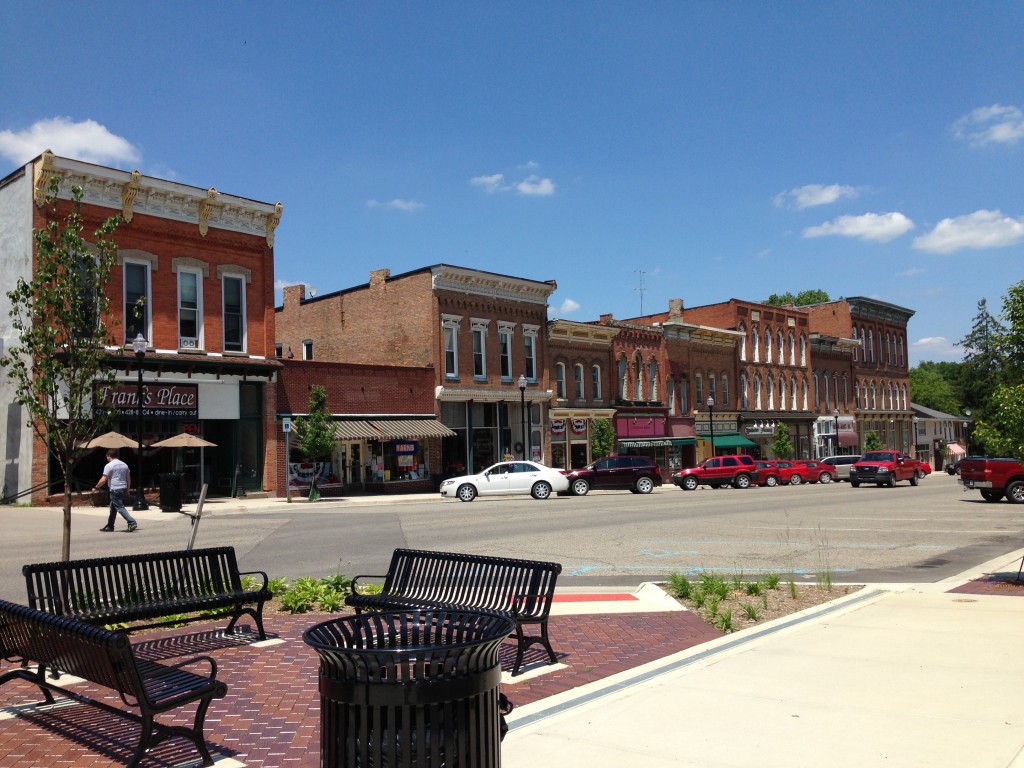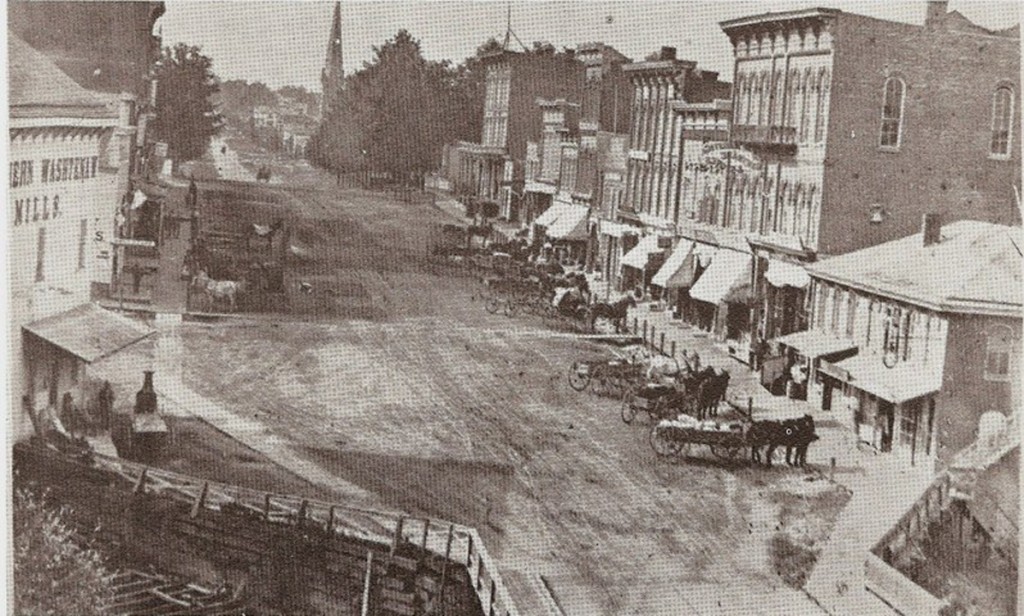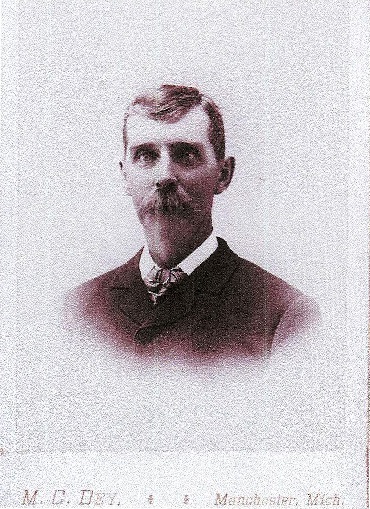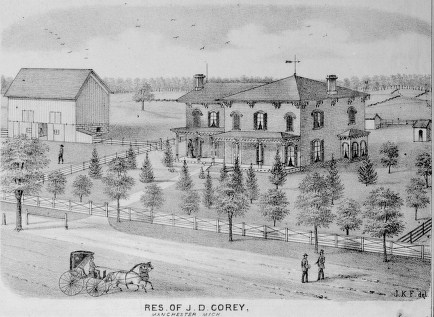Manchester’s Streetscape – 1870 (Part 1 of 2)
As this article is published in July 2015, the Village of Manchester is preparing for a complete replacement of its Main Street Bridge, a project several years in planning. The previous history of the bridge was reported in a set of earlier articles in The Manchester Mirror. The new bridge design replicates some historic elements of an earlier bridge, and will be a welcome sight after years of temporary barriers and restricted traffic. The Village will also see new informational way signs installed at the M-52/Main Street intersection and by the Post Office, the construction of the Shared-Use Trail, and the beginning plans for riverfront improvements and recreation activities.
The Village completed a downtown “streetscape” improvement program in 2012, associated with the major reconstruction of the M-52 highway through the village limits. Upgrades included new sidewalks, street lights, seating areas with benches, decorative trash receptacles and planters, and improved curb cutouts and accessibility ramps. The streetscape project removed many existing trees in the downtown area and along M-52, replacing them with “historically appropriate” trees after negotiations with the Michigan State Historic Preservation Office. Some residents noted how “exposed” the downtown 19th century Italianate buildings appeared, having lost their former tree cover.
These structural and streetscape improvements caused us to look back at a similar event in Manchester’s past. A good example can be found in the post-Civil War boom period, particularly around the year 1870, where downtown Manchester experienced significant commercial construction, streetscape improvements, some arguments and disagreements, but definitely pride in its future.
Let’s go back…
The 1865-1870 Economic Boom
The Civil War affected Manchester area farmers by driving up both the demand for and price of farm products, greatly increasing their income. This resulted in increased demand and sales of the manufactured goods, products and services which the downtown merchants provided. With the end of the war in April 1865, village leaders looked for means to assure that the economic boom continued. One way to accomplish this, as Mat Blosser put it in the Manchester Enterprise, was to “build up the town”. The construction of much of Manchester’s Italianate downtown buildings in the late 1860s-early 1870s was a direct result of this idea. A second means of assuring that good times continued was a civic campaign to fund and bring a second railroad to the village. This became a reality in 1870 with completion of the Detroit Hillsdale and Indiana Railroad.
A village the size of Manchester having two competing railroads was viewed as a boon to merchants and farmers for their products. A tremendous expansion of the nation’s rail system followed the Civil War and this opened markets to western producers that had previously been unavailable or too expensive to reach. Manchester, like hundreds of other villages, bet its future on becoming a railroad town. Village leaders lost little time in promoting Manchester as second only to Ann Arbor in terms of its potential for growth.
By late 1870, this economic boom was in full swing, and the Manchester Enterprise reported weekly on the opening of new businesses, the arrival of new residents, and the overall prosperity of the village. Decisions made 145 years ago are partly responsible for Manchester’s present physical appearance, as well as a strong sense of community and the willingness to give to make it grow and prosper. Mat Blosser certainly took an active role as editor of the Enterprise to promote and rally readers to the cause, but there was also a group of civic leaders, led by Jeremiah D. Corey, who rallied the business owners, educators, local government and the area farmers to launch an aggressive campaign of growth and investment in Manchester.
Jeremiah Corey and His Vision
Jeremiah D. Corey was born in Onondaga County, N. Y. in 1816, and moved first to Lodi Township in 1833, then to Sharon Township, then Manchester Township in 1844. He was a farmer, teacher, township supervisor, state representative and senator, bank director, and judicial officer. But most relevant to this story, he initiated the efforts to organize Manchester as a village, which occurred on March 16, 1867. The first election of village officers was held at the Union Hall on March 18, 1867, when Newman Granger was elected President. Alvinza S. Doty was the Recorder and Philetus Coon the Treasurer.
Corey also created and advocated a vision of what Manchester could become. He was a strong proponent of the second railroad, and invested both his own money and successfully convinced local residents to purchase stock in the railroad to finance its construction through Manchester. He convinced village officials through petition to allow the DHI Railroad the “use of Jefferson and Madison Streets by the DHI Railroad as much as they wanted, provided they leave the route passable by wagons, carriages and other travel.”
Some of the Manchester vision elements completed through the efforts of Corey and other leaders in this time period were:
- In October, 1867, the announcement that the Union School would be open on November 4th of that year was received with enthusiasm. The Union School was completed in the area known as the "old swail." The three-story brick structure cost $25,000. Bonds were issued for that amount. It was pointed out that a Union School is systematic and orderly. "Children must obey for the principal is king. Children do not go to school under the direction (much less whims) of parents—only in so far as they coincide with the principal and teachers." Manchester now had a “modern” school espousing the latest educational theories.
- The new Goodyear Hall brick block was dedicated Nov. 22, 1867. The size was 50 x 80 feet with a large stage and beautiful scenery. The building was owned by Henry Goodyear. Professor Beck's band played and a supper was served at Exchange Hotel on the opening night.
- By 1869 there were three dams and the river afforded unlimited resources for manufacturing. J. S. Reynolds kept the mill in operation night and day, turning out an average of 150 barrels of flour per day. Porter & Jaynes Woolen Mill across the street manufactured 100 yards of wool a day. Plans were underway for a Planing Mill, and a Sash & Blind factory.
- Time “changed” in 1869. The Standard Time of the Lake Shore & Michigan Southern Railway Company was Cleveland time. The telegraph operator at Cleveland would telegraph the time to all operators at 12 noon on Sunday and clocks were set. With the arrival of the telegraph system in Manchester in September 1869, we were truly connected with the whole world.
- On March 4, 1869, Mat Blosser stated “Manchester needs a bank where a responsible mechanic, farmer or manufacturer might borrow money (with proper security) at a reasonable rate of interest, say ten or twelve percent, not a fraction above the latter.” The first “legitimate” bank opened on July 28, 1871, when the Peoples Bank with capital of $50,000 started business. Officers were: L. D. Watkins, president and J. D. Van Duyn, vice president.
- September 22, 1870 – “The Unterkircher & Daily block (i.e., Manchester Pharmacy) will soon be completed. The Kerfus Block (i.e., building between The Village Tap and Marti’s Salon) is also nearly finished. Clarkson’s Block (i.e., former Manchester Bakery) is receiving its finishing touches. When occupied these will make three of the finest block of stores in the village.”
- On October 6, 1870, Blosser noted “A large number of residences are being built this fall.” This included several new brick homes up Ann Arbor Hill, including the new home of Jeremiah D. Corey at what is now 329 Ann Arbor Street.
- October 27, 1870 – “The first regular train over the Detroit, Hillsdale and Indiana Rail Road arrived at about 10:40 a.m., on Monday last. It was greeted by a large group of our citizens, who, with anxious eyes and gladdened hearts hailed its coming. It arrived under the charge of conductor Mr. MARK GERRY, an old and experienced Central conductor. The train was drawn by engine No. 139, and consisted of two freight cars, a baggage and express car and a superb passenger coach, the latter of which came loaded with quite a number of passengers. At 2:20 PM the same train left our village, the freight cars, Blue Line, Nos. 694 and 754 for New York City, laded with 100 barrels each of extra flour from the Southern Washtenaw Mills, Messrs. Reynolds and Hewett proprietors.”
All of this rapid growth led to another growing problem - disputes over boundary lines and corners of properties.
We’ll come back to this next week in Part 2…












You must be logged in to post a comment Login